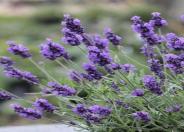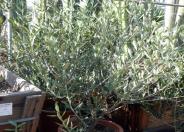
Common name:Hidcote English Lavender
Botanical name:Lavandula angustifolia 'Hidcote'
This is a slow growing lavender that grows to 1' tall with deep purple flowers. It is drought tolerant and attracts hummingbirds and butterflies. -Cornflower Farms

Common name:Magenta Magic Spanish Bayonet
Botanical name:Yucca aloifolia 'Magenta Magic'
Spiky upright lustrous mauve leaves make a dramatic garden statement! Reaching only 2-3’ tall and wide, this accidental sport of Yucca ‘Blue Boy’ is a natural dwarf variety with dark evergreen foliage that deepen to purplish mauve in cooler temperatures. 2-3’ tall spikes of white nodding flowers shoot above the foliage in late Winter on mature plants. Berries follow, much loved by birds, but ignored by deer. Tough and durable, it can take heat, dry conditions and a fair amount of neglect. Makes a dramatic statement when planted en masse and combines well with other dry garden denizens. An excellent container plant. Plant in well-drained soil.

Common name:Bush Anemone
Botanical name:Carpenteria californica
This California native is a dense, clean evergreen shrub that grows 4-8 ft high and 5 ft. wide. It is tolerant of sun or shade. It has white fragrant flowers from May - August.
-Cornflower Farms

Common name:Western Redbud
Botanical name:Cercis occidentalis
This deciduous shrub ranges from 6-20 ft. tall and 10-15 ft. wide. It is desirable for its magenta spring flowers, yellow to red fall color, and dangling winter seed pods. It is tolerant of many soil types, drought and oak root fungus. It attracts hummingbirds and butterflies. The Western Redbud can be found statewide in California in the foothills below 4500 ft. elevations in chaparral and woodland communities
- Cornflower Farms

Common name:Gray Globe Mallow
Botanical name:Sphaeralcea incana ‘Kathy Echols’
My favorite prolific bloomer in our dry garden! I love its dense upright 3’-2’ bushy habit, absolutely stunning silvery foliage, and wow, then there are these unusual flowers. Beloved Bay Area horticulturalist Kathy Echols somehow came across this beautiful variant with orchid pink flowers (instead of the usual dull orange) that are larger than normal- 1.25” across. and this marvelous DROUGHT TOLERANT North American native blooms from late Spring through Fall! What more do you need? Deer resistant? Yes! I cut ours back to 1’ tall in late Fall for perfect form next season. Well-drained soil is a must and a smidge of compost side-dress in Spring is not a bad thing. Root hardy to 10 degrees F.

Common name:English Lavender
Botanical name:Lavandula angustifolia 'Twickel Purple'
This form of English lavender makes compact shrubs about 2 foot in height with rather tightly packed, narrow grey leaves with a spicy perfume. The purple flower clusters are borne well above the foliage in spring and summer. It can be intolerant of poor soil drainage and winter wet, but is useful in sunny borders and on open banks. Full sun, well drained soil, moderate to occasional watering. Hardy to 0 degrees F. or less. Attracts birds and butterflies. Deer resistant. Beautiful for Mediterranean garden.

Common name:Olive
Botanical name:Olea europaea 'Skylark Dwarf'
Introduced in the late 1960s, this olive was selected specifically as an ornamental, being shrubby and small (probably 10 feet at maturity) and having neat rows of branches set with equally neat rows of smallish, gray-green, elliptical-shaped leaves. It sets few, sometimes no fruits unless a different olive is nearby to act as a pollinator. Sun, reasonably well drained soil, only occasional watering when established (olives are nearly as drought tolerant as our native oaks). Hardy to 15 degrees F. or less. Slow growing. Cream colored flowers appear in summer.
Designer: Homeowner
Photographer: Vicki Anderson
Maintain a two to four inch layer of mulch on the soil surface to reduce weeds, infiltrate rain water, and reduce compaction.
Attract, or buy beneficial insects such as ladybugs and lacewings to control pest outbreaks in your garden.